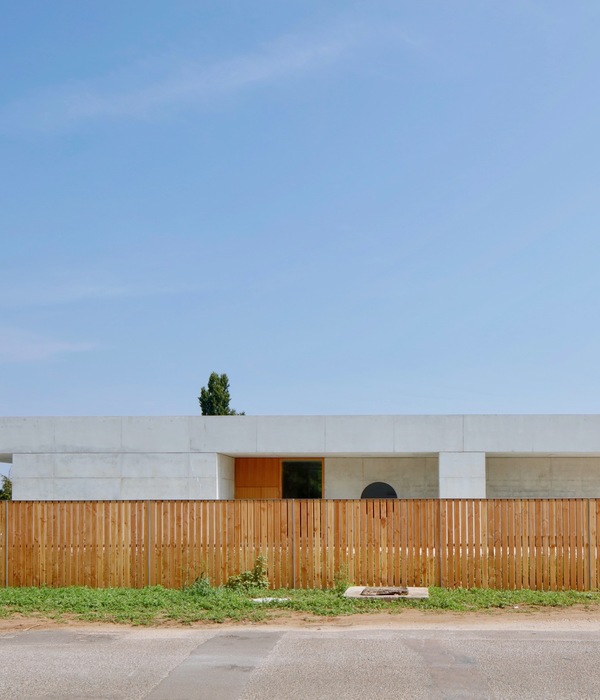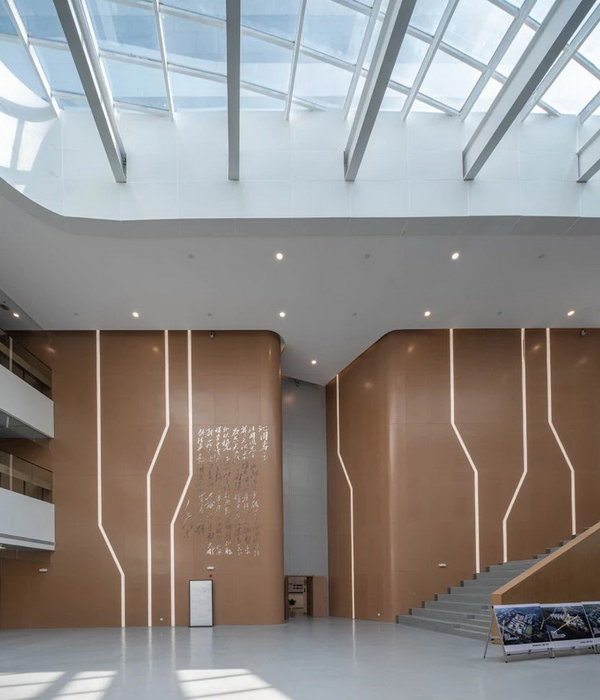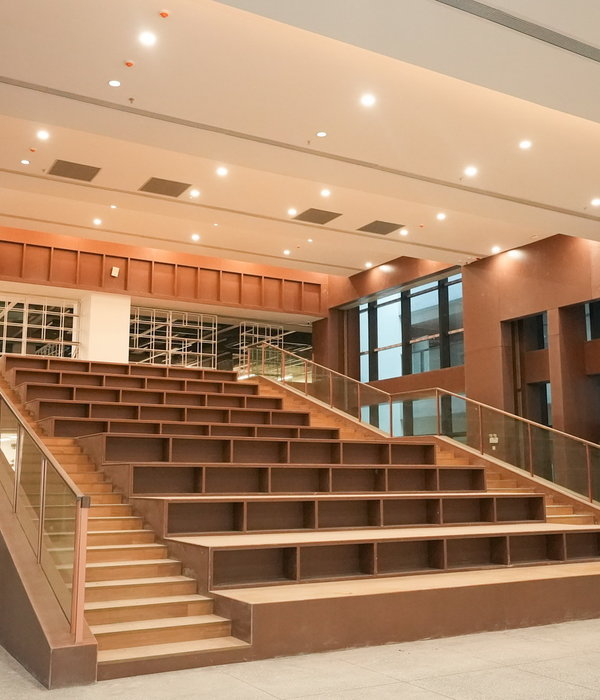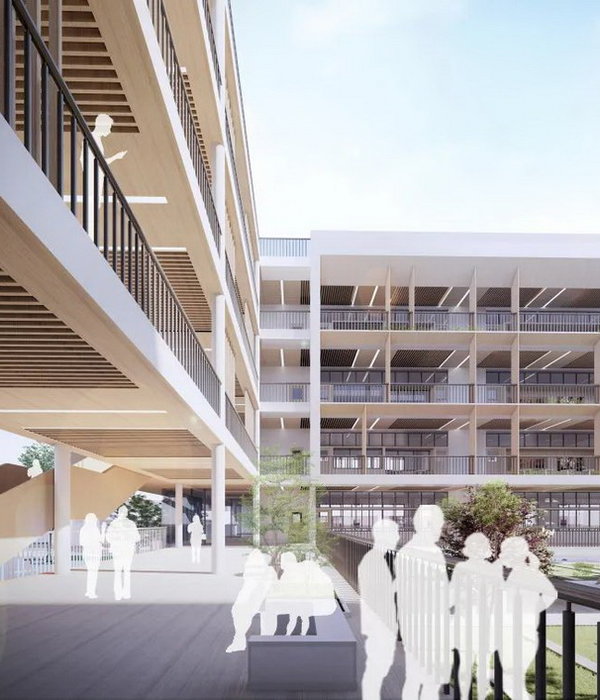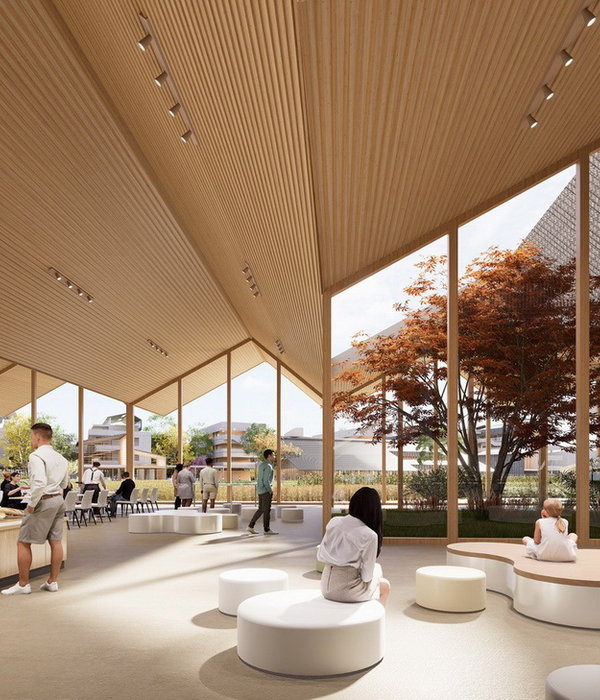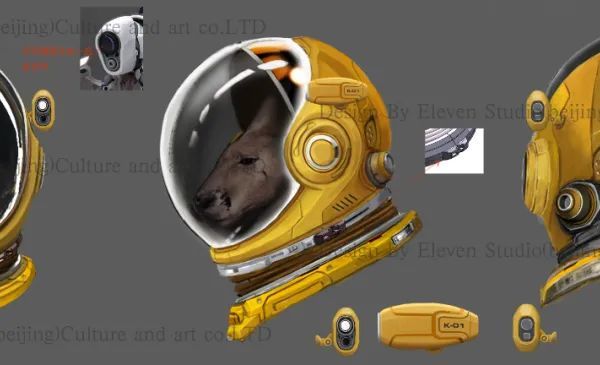- 项目名称:绩溪博物馆
- 建筑事务所:李兴钢建筑工作室
- 主创建筑师:李兴钢,张音玄,张哲,邢迪,张一婷,易灵洁,钟曼琳
- 项目完成年份:2013年
- 摄影师:夏至,李兴钢,李哲
- 结构设计:王立波,杨威,梁伟
- 景观设计:李力,于超
- 机电设计:何猛,李京沙,张千,李俊民,丁志强
绩溪博物馆位于安徽绩溪县旧城北部,基址曾为县衙,后建为县政府大院,现因古城整体纳入保护修整规划,改变原有功能,改建为博物馆。包括展示空间、4D 影院、观众服务、商铺、行政管理、库藏等功能,是一座中小型地方历史文化综合博物馆。
▼全景鸟瞰,aerial view ©李哲
Jixi Museum is located in the north side of the old town area in Jixi County, Anhui Province. The site was the seat of the town hall throughout history and different regimes. Now because of the comprehensive preservation and restoration program for the entire old town, the site is reprogramed and a comprehensive museum on local culture and history that will have exhibition spaces, a 4D cinema, citizen services, shops, administration and storage functions will be located here.
▼西南方向全景,overview from southwest ©夏至
▼屋顶夜景,roof scape in the evening ©夏至
建筑设计基于对绩溪的地形环境、名称由来的考察和对徽派建筑与聚落的调查研究。整个建筑覆盖在一个连续的屋面之下,起伏的屋面轮廓和肌理仿佛绩溪周边山形水系,是“北有乳溪,与徽溪相去一里,并流离而复合,有如绩焉”的“绩溪之形”的充分演绎和展现。待周边区域修整“改徽”完成,古城风貌得以恢复后,建筑将与整个城市形态更加自然地融为一体。
The design is based on surveys on the landscape and origins of Jixi’s name, and investigations & studies on the Huizhou-style settlements. The entire building is covered under a continuous roof with undulating profile and texture that mimics the mountains and waters surrounding the county. It is the logical result and expression of “Jixi’s shape”. Once the other buildings in the old town are restored back to the Hui style, the museum will fit in even more naturally with the entire town.
▼南立面局部,south facade detailed view ©夏至
为尽可能保留用地内的现状树木(特别是用地西北部一株700 年树龄的古槐),建筑的整体布局中设置了多个庭院、天井和街巷,既营造出舒适宜人的室内外空间环境,也是徽派建筑空间布局的重释。建筑群落内沿着街巷设置有东西两条水圳, 汇聚于主入口大庭院内的水面。
In order to preserve as many of the existing trees on the site as possible, multiple courtyards, patios and lanes are introduced into the overall layout of the building, and at the same time as a reinterpretation of the spatial layout of the vernacular Huizhou architecture, and creating comfortable outdoor spaces. Two streams run along the lanes, one on the east and the other on the west of the cluster of buildings, finally converging into the pool in the large courtyard at the main entrance.
▼庭院与古槐,courtyard with an ancient tree ©夏至
▼“山院”保留树木,the existing trees are preserved in the Mountain Yard ©李兴钢
▼“水院”,Water Yard ©李兴钢
▼池岸细部,pool and deck ©夏至
▼主庭院一角,main courtyard ©李兴钢
建筑南侧设内向型的前广场——“明堂”,符合徽派民居的典型布局特征,同时也符合中国传统的“聚拢风水之气”的理念;主入口正对方位设置一组被抽象化的“假山”。围绕“明堂”、大门、水面有对市民开放的、立体的“观赏流线”,将游客引至建筑东南角的“观景台”,俯瞰建筑的屋面、庭院和秀美的远山。
▼主庭院折桥,the folding bridge in the main courtyard ©夏至
▼主入口正对方位设置一组被抽象化的“假山”,directly opposite the main entrance is a group of abstract “rocks” ©夏至
In the south part of the building is “Ming Tang”, an interior courtyard common in the typical layout of Huizhou-style houses and follow the traditional Chinese Fengshui principles. Directly opposite the main entrance is a group of abstract “rocks”. Surrounding “Ming Tang” is a “sightseeing route” that guides tourists to the “sightseeing platform” at the southeast corner of the building, where they can have a bird’s eye view of the roof-scape, courtyards and distant mountains.
▼庭院局部,courtyard detailed view ©夏至
▼曲折路径穿越洞口消失在庭院深处,the pathway leads to the depths of the courtyard ©夏至
▼展厅室内,interior view of the exhibition hall ©夏至
▼序言厅室内,Preface Hall ©夏至
规律性组合布置的三角屋架单元,其坡度源自当地建筑,并适应连续起伏的屋面形态;在适当采用当地传统建筑技术的同时, 灵活的使用砖、瓦等当地常见的建筑材料,并尝试使之呈现出当代感。
Triangular steel structural trusses (their slopes are derived from the local building) adapt well to the undulating roof. Local building materials such as bricks, clay roof tiles are used in modern and innovative ways to pay respect to history yet respond to our own times.
▼内街与水圳,inner path and canal ©夏至
▼登上观景台的楼梯,staircase leading to the rooftop ©夏至
▼屋顶观景台,viewing platform on the rooftop ©夏至
▼建筑、树木和远山,a dialogue among the architecture, woods and mountain ©李兴钢
▼场地平面图,site plan
▼一层平面图,ground floor plan
▼北立面图,north elevation
▼南立面图,south elevation
▼剖面图1-1,section1-1
▼剖面图2-2,section2-2
项目名称: 绩溪博物馆
建筑事务所: 李兴钢建筑工作室
主创建筑师: 李兴钢、张音玄、张哲、邢迪、张一婷、易灵洁、钟曼琳
项目详细地址: 安徽绩溪
项目完成年份:2013年
建筑面积(平方米): 10003平方米
摄影师: 夏至、李兴钢、李哲
结构设计:王立波、杨威、梁伟
景观设计:李力、于超 机电设计:何猛、李京沙、张千、李俊民、丁志强
{{item.text_origin}}

